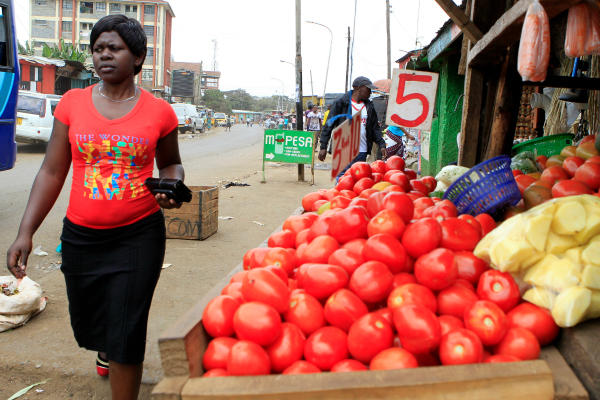
A woman walks past tomatoes. Tomato prices have started falling. Photo by Development of rural areas.
As consumers continue to pay high prices for various commodities in Kenya, the price of basic commodities may start dropping- two months into the rain season.
Tomatoes, whose price for instance shot to sell at about Sh7,500 per crate of 64kg in various towns of Kenya, has dropped to Sh2,500 in Nakuru.
Nakuru is one of the main farming regions in Kenya, with Subukia being the bedrock of tomatoes, cabbages, Irish potatoes, among other crops.
Nairobi, which in April paid Sh5,760 per 64kg crate of tomatoes is buying the same quantity at Sh5,120 on wholesale.
Mombasa, which paid Sh102 for every one kilogramme of tomatoes, is buying the same quantity at Sh78.
Eldoret town remains the most lucrative tomato market as the 64kg crate sells at Sh7,000 on wholesale. This price is more than twice what Nakuru is offering despite being a neighbour town in the Rift Valley.
Wholesalers in Malindi, a town in the Coast region, are paying about Sh55 per kilo according to the Agriculture and Food Authority commodity cost list of this week.
READ ALSO: Tomato prices rising against low supply
READ ALSO: Tomato farmer lights lantern at night to trap more fruit flies
READ ALSO: Ripe tomatoes sold for 30 days
Tomato is one of the most popular horticultural crops consumed by almost all classes of people in as an ingredient in various cooked and raw delicacies.
Despite the spark of the tomato price t any time, consumption still remains high in the various classes of society.
In April, the cost of one tomato rose to Sh10. In some places like Ongata Rongai, four fruits cost Sh50 or more.
Besides Nakuru, Loitoktok town is also selling the tomatoes at a relatively cheaper price that most towns.
On wholesale, it costs Sh3,500 per crate of 64kg. Loitoktok is one of the main agriculture producing regions in the South Rift.
Loitoktok does not receive sufficient rain to support all-year round farming. Farmers have invested in irrigation to tap into the still fertile soil at this region, which has been traditionally a pastoralist region.
The price of milk is expected to come down in about two months after the pastures recover from the four-month long dry spell experienced from mid November last year to March 2017.
Write comment (0 Comments)
















